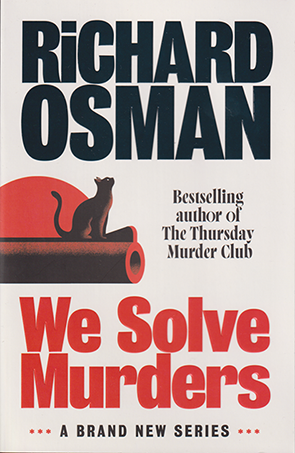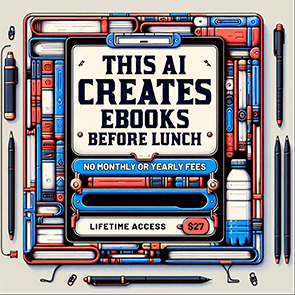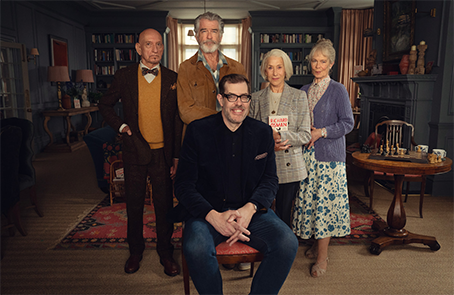In the fading hours of 2024 I received a promotional email from Dymocks, a major book retailer in Australia, that listed their top ten selling books for the year. I opened it and discovered that the book I had almost finished, We Solve Murders by Richard Osman, was Dymocks’ sixth highest seller in 2024. Osman’s first book, The Thursday Murder Club, published in 2020, still managed to make the list at number ten. No other book I read in 2024 had made the list. The only other author to make the list twice was Sarah J. Maas (at numbers seven and eight: A Court of Thorns and Roses and House of Flame and Shadow.
We Solve Murders is one of those novels that always had a good shot at making a list like this. Its author is a well-known British television celebrity whose geeky looks and manner scream intelligence, and who is an appealing and likeable personality. Trading on his celebrity, Osman was able to turn his first book and its subsequent series, The Thursday Murder Club, into one of the best-selling crime franchises of the last half decade. The adaptation of that book for the screen is now nearing completion, starring Helen Mirren, Ben Kingsley, David Tennant, Pierce Brosnan, Jonathan Pryce and other notable actors. It is currently due for release on Netflix in the second half of this year.
Apart from Osman’s high profile, the books are probably popular because they are middle-of-the-road, bland and unchallenging. With over a hundred chapters, it feels like the novel is written to be adapted into a movie script. Each chapter is a scene, cutting from one to the next, predominantly focussed on dialogue and action. The characters traverse the globe – it’s all very glamorous – to chase their Bad Guys, but each location feels undifferentiated. All this is not a criticism, just an observation. The writing is competent but never inventive and the characters are easily definable as a formulaic mix, each with a set of quirks, along with set of motifs – Steve’s bench, Rosie’s private jet, Amy’s physical skills – to define an identifiable world so as to establish a series of books readers will understand the moment they return to them. In his acknowledgements pages Osman highlights the familiar tropes his audience has come to expect from his writing: “I think I mentioned ‘Twix’, ‘Greggs’ and ‘Lee Child’ within the first fifteen pages or so. Which I imagine was a relief to us all.” And he is firmly aware of the quirks that already define his new characters:
I hope there was something in Amy, Steve and Rosie that you could take into your hearts. They will be returning soon, I promise, and I guarantee that Steve will be flying around the world against his will, and Amy will probably jump out of a helicopter, while Rosie arches an eyebrow and mixes the perfect Martini.
Yes, Steve is a stay-at-home guy forced into action. Amy is Action Girl who needs Steve’s detective acumen. And Rosie is a rich novelist – the second most successful in the world after Lee Child – who brings money and a lustful swagger to the group. Apart from what Osman is telling us here about his new characters – assuming you haven’t read the book and already know – is that it is extremely important that his audience likes them. And the best way for Osman to achieve this is to make them uncomplicated: a bit like us in one way or another, but with money or talents which make them aspirational. Steve is Amy’s father-in-law. He’s an ex-cop enjoying his retirement with a small group of friends, and frequents a local pub where he enjoys trivia nights. He clearly inhabits the everyman role. His wife, Debbie, has died from a train derailment. Steve misses Debbie and his devotion to her is sweet. He has had a local bench dedicated to her with a memorial plaque (you just know this bench will become a familiar motif in later books) and he uses an old-fashioned Dictaphone to record his thoughts to her: that’s going to be used again, too. Steve gets on better with Amy than he does with his son, Adam, who seems mostly absent on oversees business. But Adam is a Good Guy. Osman takes pains to assure us that Adam isn’t using his absences to play around with women. No! The characters on this side of the page are the Good Characters, even if they have to suspect each other of being Bad Characters from time to time, otherwise the plot would be exceedingly boring, and the characters on the other side of the page are Bad Characters, even if they seem to be good characters from time to time, otherwise the plot would be exceedingly boring. Except for those characters whom we simply don’t know enough – the subject of a few mis-directions to keep things interesting and not boring – and they will surprise us in charming and surprising ways!
The basics of the plot are that a series of medium-to-low-level social media influencers who have had some connection to Amy and Jeff Nolan’s security firm, Maximium Impact Solutions, have been murdered, all in locations near Amy, and all, it eventually turns out, with large amounts of cash on them when they were murdered. You know how this story goes. Amy is going to be framed for the murders, Jeff is going to suspect Amy, Amy is going to suspect Jeff, they’re both going to suspect Henk, Jeff’s former business partner, and he them, and this is going to go around and around until the bottle stops and an unlikely suspect is pulled from the minor character pool, and we hear something of a backstory to make sense of their motivations and their certain slide into Bad Guy status. That’s the whole book in a nutshell . . .
Of course, the Good Guys all bring talents with them – Amy’s fighting ability for instance – and they’re all exceedingly good at what they do. They outwit the Bad Guys easily, until it would insult our intelligence for them to do it anymore, and then there is a twist and they still manage to evade the certain consequences visited upon the cadre of pitiful victims of the Bad Guy whose deaths started all this: those hopeful but somewhat pathetic influencers. So, there will be a social media influencer in the plot who will be appealing enough to us for us to care whether she lives or dies, and who will help soften Osman’s satirical treatment of social influencers so no one is offended.
Let’s leave these mildly interesting but one-dimensional characters for you to discover if you read this highly popular book. After all, Osman needs you to like them enough to return for a second and third book in the series. But their determined goodness is also needed them to balance out the grim reality of the modern world. In Osman’s iteration of our modern world, it is almost impossible to know something if the plot requires it, or exceedingly simple to overcome the obstacles placed to stop someone knowing what they want to know, if the plot requires it. Do you need to get security footage from an airport? Sweet. You know our Good Guys are up to finessing that social interaction. And you know that our Bad Guys are not! But then there is the underlying issue of modernity, itself: that it is becoming harder and harder to know people. And I don’t just mean the problems of social isolation, although there is a little bit of that, or the difficulties presented by misleading or false identities online. Osman is focussing on the next level up: not only the totally manufactured identity, but the manufactured presence.
Osman starts his book upon this premise. François Loubet, our main Bad Guy who is all smoke and mirrors and believes he is untraceable, uses ChatGPT. If you are interested in finding out more about this real website you can visit it, but it will only let you try two or three things before it throws up a paywall. Apparently, it is an AI that can answer questions, create images from text and help develop pieces of writing or even online presences. François Loubet uses the technology to hide his identity by changing his apparent nationality and social status based upon writing the bot produces, which is created from Loubet’s own written inputs. Loubet’s occasional missives, used for the purposes of exposition, begin “ChatGPT, rewrite in the style of a friendly English gentleman please”, and that is what is turned out. Even when Loubet is being threatening, there is a disconnect between his message and the English bonhomie of his tone. I wondered as I read whether Osman had written these chapters in the real voice of Loubet and then had the bot rewrite them for him. Some of the expression is stilted enough to believe this is what he did.
What this represents is an emerging world in which no-one you think you know may be anything remotely what they really are: in which intelligent bots can oversee all that is produced to make sure there is no human failing in the created façade. You don’t need to know much to succeed in a world in which you have the tools of technology. How do employers access applications in a world increasingly online? How do we trust anything? This review – this entire website – might be the product of such a bot, and you wouldn’t know. I can assure you that that is not the case, but by the time we’ve reached this impasse, where I have to assure you I am a real person writing, being told that something is true is really not helpful. It is the promise of Postmodernism, the fearful and depressing sense of purposelessness taken to an extreme, in which nothing is known, everything is fake, and no meaning exists. It’s depressing!
Osman can’t avoid this modern reality if his plot is to work, but his panacea is a comforting group of characters with known issues and quirks who possess the skills and determination to come back for a second novel. Oh, let’s form a Scooby gang and make the world a better place by replicating our character tropes in a second instalment. We need a name. What about Maverick Steel International Investigations? Nah, too corporate and impersonal. That’s the problem, isn’t it? What about keeping it simple, like We Solve Murders? Sure, that’s a “Great name for a book.” A knowing wink to the readers. We’ve settled on a folksy name. Curtain (for now).
And that’s all I really have to say about this book. Go join the multitudes who are reading Richard Osman. It’s not a challenging read, but there is comfort in the familiar and reassuring, and that’s what Osman is offering us.

 RSS Feed
RSS Feed Facebook
Facebook Instagram
Instagram YouTube
YouTube Subscribe to our Newsletter
Subscribe to our Newsletter





No one has commented yet. Be the first!